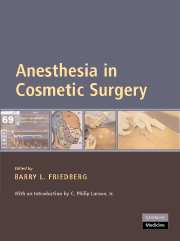Book contents
- Frontmatter
- Contents
- Foreword
- Acknowledgments
- Introduction
- Preface
- List of Contributors
- PART I MINIMALLY INVASIVE ANESTHESIA (MIA)Ⓡ FOR MINIMALLY INVASIVE SURGERY
- PART II ALTERNATIVE ANESTHESIA APPROACHES IN COSMETIC SURGERY
- PART III OTHER CONSIDERATIONS FOR ANESTHESIA IN COSMETIC SURGERY
- APPENDIX A A Guide to Perioperative Nutrition
- APPENDIX B Reflections on Thirty Years as an Expert Witness
- Index
- References
APPENDIX A - A Guide to Perioperative Nutrition
Published online by Cambridge University Press: 22 August 2009
- Frontmatter
- Contents
- Foreword
- Acknowledgments
- Introduction
- Preface
- List of Contributors
- PART I MINIMALLY INVASIVE ANESTHESIA (MIA)Ⓡ FOR MINIMALLY INVASIVE SURGERY
- PART II ALTERNATIVE ANESTHESIA APPROACHES IN COSMETIC SURGERY
- PART III OTHER CONSIDERATIONS FOR ANESTHESIA IN COSMETIC SURGERY
- APPENDIX A A Guide to Perioperative Nutrition
- APPENDIX B Reflections on Thirty Years as an Expert Witness
- Index
- References
Summary
According to the author, nutritional supplementation in the period before and after surgery can have a significant impact on surgical outcome by reducing bruising, swelling, and inflammation; promoting wound healing; enhancing immunity; and reducing oxidation generated by surgery and anesthetic agents. However, supplements must be administered judiciously; some popular herbal products are contraindicated before and after surgery. Insufficient nutrition impairs wound healing and leaves surgical patients more susceptible to perioperative complications. By addressing nutritional status and providing focused guidance on nutritional supplementation, the aesthetic surgeon can positively influence surgical outcome.
OBESITY, AGING, AND NUTRITION
The risk of death from comorbid conditions increases exponentially as weight increases. Patients who are poorly nourished, obese, and, especially, diabetic are particularly prone to surgery-related complications, including wound infection and poor healing. Most Americans consume diets too high in calories and deficient in essential nutrients. More than 70% of American adults do not even get two thirds of the recommended daily allowance (RDA) for one or more nutrients; consumption of fruits and vegetables is notably poor. American meals, loaded with packaged, processed, nutrient-poor foods, contribute to marginal deficiencies that result in a shortage of micronutrients and antioxidants that are particularly important to surgical patients undergoing anesthesia, trauma, and wound healing. Older patients are more susceptible to wound-healing problems because of the interactions of body systems, environmental stresses, and disease. Although they have the capacity to heal well, older patients have a slower recovery rate.
- Type
- Chapter
- Information
- Anesthesia in Cosmetic Surgery , pp. 241 - 247Publisher: Cambridge University PressPrint publication year: 2007

